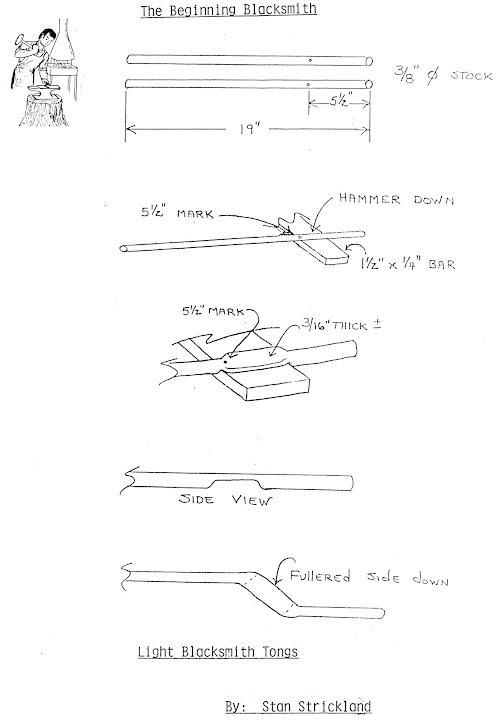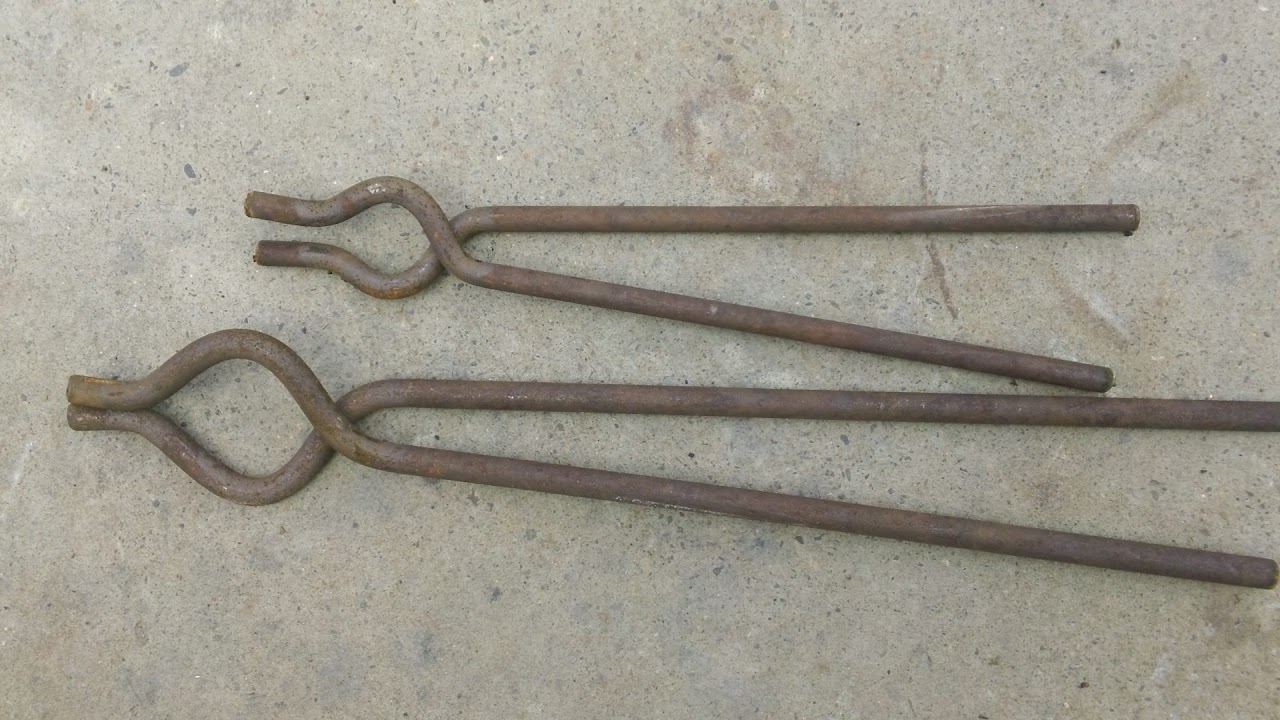This is my persona blog for sharing things I figure out as a dabble in blacksmithing, armoring and other metal work, I hope you enjoy
Sunday, May 8, 2016
Making a Dog Wood Flower
Here is a simple pattern I made for dogwood flowers
Turn out like this
You make it pretty much like a rose.
Sunday, May 1, 2016
Tongs made from Nippers
I wanted to put a couple pics up if different tongs made from nippers.
If you forge them cut out teh rivet, forge the jaws and put them back together, but below are a couple ways you can make tons without cutting them first...
Just weld angle or cut tubing on to the tips


Rail Road spike holding tongs
Friday, January 29, 2016
How much does my british anvil weigh?
Many english anvil are marked in the hundred weight system... we poor yanks don't seemto grasp it first try...
THere's an app for that... well a web page anyway...
Anvil weight calculator
Sunday, January 24, 2016
A Great way to make your anvil quieter.
My anvil rang lie a bell, so i got some stainless chain (no zinc to burn off an make poisonous gas)
and wrapped it around.
This way looks better, way quieter.
I'll be doing this next time.
How to test an Anvil for rebound
When you get an anvil, first you want to know is it a good anvil, or what's calle an ASO (Anvil Shaped Object)
Some places (Harborfreight in particular) sell cheap cast as anvils that just don't' work right, it's like using a piece of scrap mild steel... the hammer absorb your energy making every hammer blow do less, and the face dents and dings all the time..
How we check which it is i called a rebound test. if a hammer or a ball bearing bounces, thats' the energy of your hammer blow getting sent into your work instead of absorbed by the anvil.
More rebound = less hammer blow to do the same work..
simply put you drop the ball bearing or the head of the hammer from a specific height, then look at what % of that height it bounces on the first bounce.... 80% is a good number.
Here is a video of it being done.
Some places (Harborfreight in particular) sell cheap cast as anvils that just don't' work right, it's like using a piece of scrap mild steel... the hammer absorb your energy making every hammer blow do less, and the face dents and dings all the time..
How we check which it is i called a rebound test. if a hammer or a ball bearing bounces, thats' the energy of your hammer blow getting sent into your work instead of absorbed by the anvil.
More rebound = less hammer blow to do the same work..
simply put you drop the ball bearing or the head of the hammer from a specific height, then look at what % of that height it bounces on the first bounce.... 80% is a good number.
Here is a video of it being done.
Friday, January 1, 2016
Tools you can make with a welder that will be a huge help, if you also have a vice.
So if you have a vice a welder (or a buddy with one), and some way to cut metal, you cam make these awesome tools that will help your metal bending immensly.
The first is just a set of simple bending forks, what' s cool is, yon can adjust these to make any
size bend in any stock. Want a tight bend, set it so the bar barely fits between the pins. Want a loosere on , play with the distance between them, or make lots of small bends close together, it will average out to a larger smooth bend...
Make two pieces that look like this
Put them in the vice and adjust the distance to fit.
Make another one of the two parts above replacing the round pin with a square one, that's 1/4 , 3/8 or 1/2 and you can pop a socket of the matching wrench size, on the square one and use it to get a precisely sized larger bend (get some old black oxide or un coated sockets for this, as it will probably ruin the temper.

you will also want one of these to fit into your anvil, or honestly several with different sized bars and spaces.. they go into and out of the hardy quickly and leave the vice open for other operations.
The best way to make hardy tools is to forge them, second best is to get square solid bar the size of your hardy and weld them up
but cheap and easy is to get 1" square tubing from the hardware store and use it to weld them up, if you hardy is smaller than 1" you just squeeze the tubing liek this till it fits, then weld it onto your tool to be the hardy post.
Some more very handy ones
Weld a stem to fit in your hardy hole on the threaded bit and one of these is darn handy

https://youtu.be/c7E0kUPcvzM
Some Very Simple Tong Designs, for guys who can't make the ones ususally taught yet, or want to build confidence.
When I first started blacksmithing every time I tried to make tongs, they never looked at all like the ones in the lessons.. It was pretty disheartening... One of the main mistakes I was doing was using too thin stock, because I was trying to avoid drawing out the reigns by hand... but ever since I've looked for really basic (but not pretty) tongs that you should be able to make day one... You might say I'm slightly obsessed about it, if you go look at the Tongs Summary Page I had to make, just to keep track of all my tong related posts... Probably because I'm still pretty bad at making pretty tongs..
These instructions are for basically very visual people, (like me) if you don't get them, at the bottom of this page is a link to Jock Dempsy style Forge and twist tongs, that is very detailed, so try that.
Here are a few workshop sheets and photos of tongs slightly more advanced than the EZ boy Scout tongs, I showed how to make before... Make a pair of those first, before you this first pair, as they are very similar.
EZ/BSA Style tong with forged reigns:
What I really like about BSA tongs and other tongs make from bar stock, is that one pair of these can be used to hold any size flat stock.. just heat up the jaws of the tong, and grab the bar, a few taps with a hammer and the jaws squish or bend to fit the barstock... They are weaker than better fancier tong designs, but this is a handy feature.
Next are tongs that I prefer, because you can do all the bending on a bending fork, making it super simple to get nice clean tight bends... I came up with these on my own and then later found this awesome worksheet someone else made using the same technique. The only thing I would do different from this is make the bends, and _THEN_ make the flat spot where the the rivet will go (the boss).. Try it both ways, see which you like better.
Bending fork and bar swedge tongs:
3/8 stock is still a little light for tongs that can do anything, but I really prefer using light tongs when
the strength of the big ones are not needed, it's just sooooo much easier to manipulate them. Most of the tongs I make are like these, or like the Cut and Weld Tongs. I make my cut and weld tongs using 3/8 bar for handles, they work OK for light stuff.
Variant on the last tongs
Next up is a variant on the last one, instead of just making a Z shape, then doing the boss, on these you do all the shaping you can on the bar, then flatten the boss, and then do the jaw.. I don't' have a worksheet, just as pic of tongs that are all bent up ready for the next step, but if you've make a pair of the Stan Strickland tongs above, you'll get it after looking at the photo.
A totally different approach.
I have not made these yet, as they required heavier stock than I have.. but I think these will be easy, and are next up on my to do list.. Again, no step by step, but i was able to figure out the steps just by looking at this in progress picture.
Here is my guess on the steps.
1. Cut your round stock to length, 18 or so inches is my guess, 3/8" or 1/2" stock, maybe have to upset to 3/4 first...
2. Forge one end into a flat taper, like on screwdriver, but leaving the end pretty thick
3. Set a large fuller on the anvil, put the tongs edge down on them and hammer till a dent is put in half way.. Stop every few hits on the swedge to flatten the taper back into shape.
After that it's just like Jock Dempsey style forge and twist tongs. speaking of which, Here is an awesome step by step tutorial on Dempsey Style forge and twist tongs, the ones I'll try after these above.
I hope this helps you learn to make a few pairs of tongs.
Subscribe to:
Comments (Atom)











